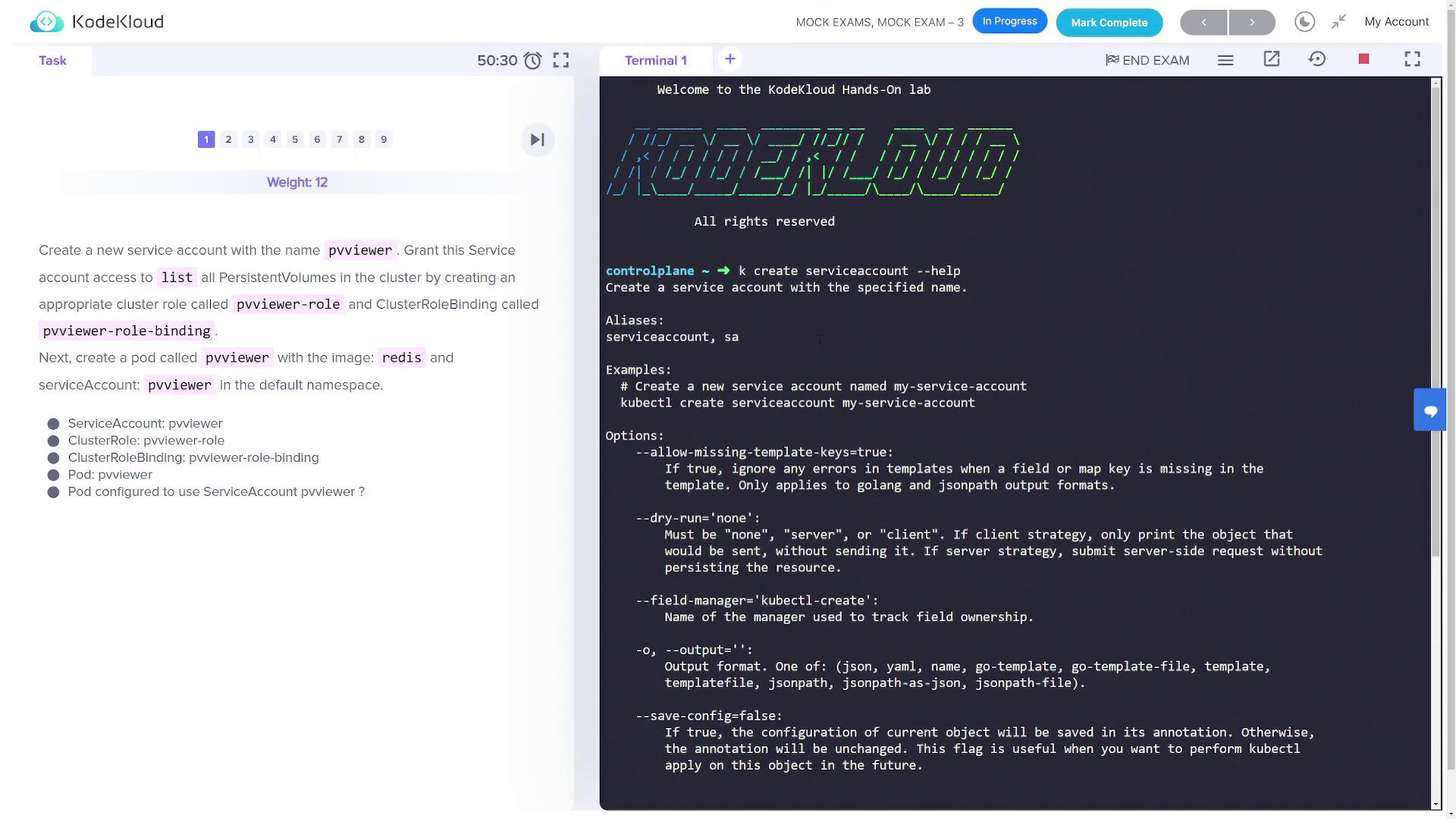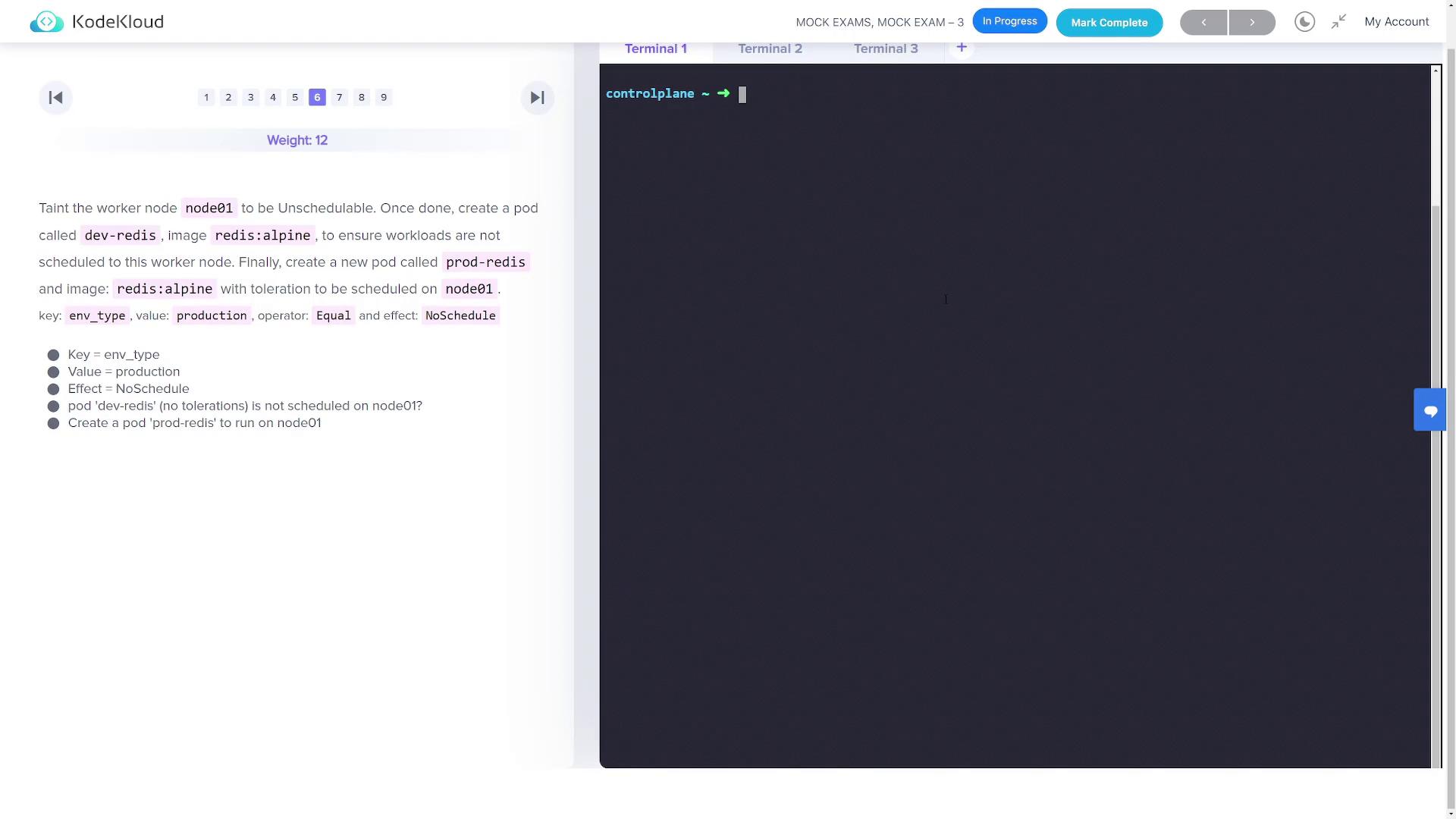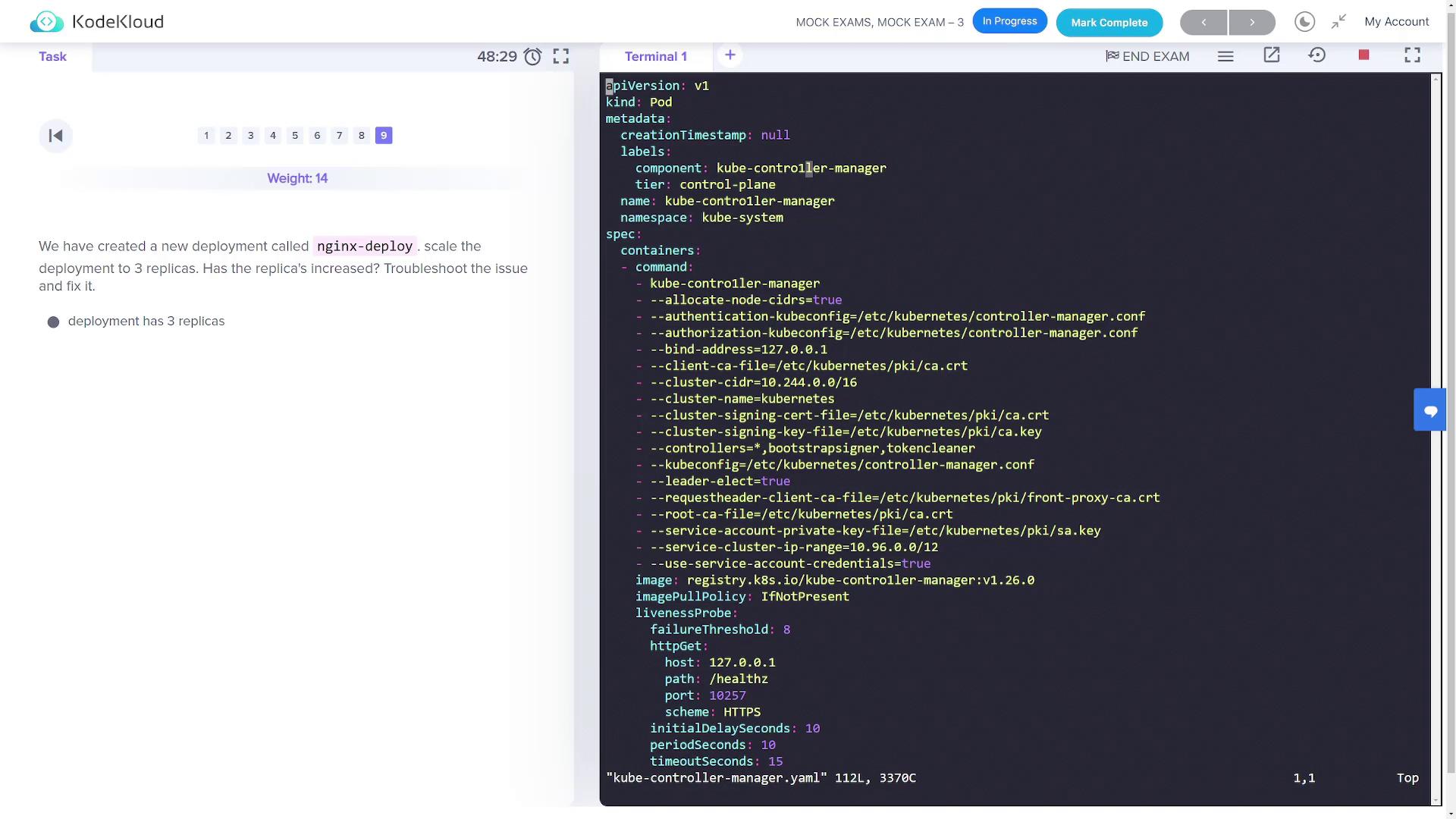CKA Certification Course - Certified Kubernetes Administrator
Solution CKA Mock Exam 3 Optional
Before diving into the solutions for Mock Exam Three, it’s important to understand the exam environment. The Linux Foundation exam page under “Important Instructions for CKA and CKAD” outlines that the exam environment is preconfigured with several useful tools. These include an alias for kubectl (k) paired with bash auto-completion, along with preinstalled utilities such as JQ, TMUX, curl, wget, and man. These settings are designed to streamline your exam experience.

Task 1: Create a Service Account, Cluster Role, and Pod
In this task, you will create a service account, a cluster role (with permissions to list persistent volumes), a cluster role binding, and finally, deploy a pod using the Redis image with the created service account.
Step 1.1: Create the Service Account
Create a service account named pvviewer and verify its creation:
kubectl create serviceaccount pvviewer
kubectl get serviceaccounts
Note
The output should list the pvviewer service account, confirming its successful creation.
Step 1.2: Create the Cluster Role
Check the available options for creating a cluster role:
kubectl create clusterrole --help
Then, generate the cluster role pvviewer-role to allow listing persistent volumes:
kubectl create clusterrole pvviewer-role --verb=list --resource=persistentvolumes
Step 1.3: Bind the Role to the Service Account
Bind the newly created role to the pvviewer service account in the default namespace:
kubectl create clusterrolebinding pvviewer-role-binding --clusterrole=pvviewer-role --serviceaccount=default:pvviewer
kubectl describe clusterrolebinding pvviewer-role-binding
Note
Ensure the binding output confirms that the pvviewer service account is correctly associated with the pvviewer-role.
Step 1.4: Create the Pod
Since the kubectl run command might not support the service account flag in all versions, start by generating a YAML manifest, update it to specify the service account, and then deploy the pod.
Generate the YAML file:
kubectl run pvviewer --image=redis --dry-run=client -o yaml > pvviewer.yaml
Edit pvviewer.yaml to include the serviceAccountName field. The file should resemble:
apiVersion: v1
kind: Pod
metadata:
name: pvviewer
labels:
run: pvviewer
spec:
serviceAccountName: pvviewer
containers:
- name: pvviewer
image: redis
dnsPolicy: ClusterFirst
restartPolicy: Always
Apply the configuration:
kubectl apply -f pvviewer.yaml
kubectl describe pod pvviewer
Verify that the pod is running with the correct service account.

Task 2: List Internal IPs of All Nodes
Your objective is to list the internal IP addresses of every node and save the output to /root/CKA/node_ips in the format shown below:
InternalIP of controlplane
InternalIP of node1
Step 2.1: Verify Node Details
List nodes with extended information:
kubectl get nodes -o wide
Step 2.2: Extract the Internal IP Addresses
Use JSONPath to extract the InternalIP addresses and write them to the file:
kubectl get nodes -o jsonpath='{range .items[*]}{.status.addresses[?(@.type=="InternalIP")].address}{"\n"}{end}' > /root/CKA/node_ips
Verify the output by displaying the file content:
cat /root/CKA/node_ips
Task 3: Create a Multi-Container Pod
You will deploy a pod named multi-pod containing two containers. The first container, "alpha", will use the NGINX image, and the second container, "beta", will use the busybox image to run the command sleep 4800. Both containers will have environment variables assigned.
Step 3.1: Generate and Edit the Pod Manifest
Generate the initial YAML manifest:
kubectl run multi-pod --image=nginx --dry-run=client -o yaml > multipod.yaml
Edit multipod.yaml to include a second container and the required environment variables:
apiVersion: v1
kind: Pod
metadata:
name: multi-pod
labels:
run: multi-pod
spec:
containers:
- name: alpha
image: nginx
env:
- name: name
value: "alpha"
- name: beta
image: busybox
command:
- sleep
- "4800"
env:
- name: name
value: "beta"
dnsPolicy: ClusterFirst
restartPolicy: Always
Deploy the pod:
kubectl apply -f multipod.yaml
kubectl describe pod multi-pod
Note
Ensure that both containers are correctly configured with their respective commands and environment variables.
Task 4: Create a Non-root Pod
Deploy a pod named non-root-pod using the redis:alpine image. This pod must run as a non-root user (user ID 1000) with the file system group set to 2000.
Step 4.1: Generate and Edit the YAML Manifest
Generate the YAML manifest:
kubectl run non-root-pod --image=redis:alpine --dry-run=client -o yaml > non-root-pod.yaml
Edit the manifest to add a security context at the pod level:
apiVersion: v1
kind: Pod
metadata:
name: non-root-pod
labels:
run: non-root-pod
spec:
securityContext:
runAsUser: 1000
fsGroup: 2000
containers:
- name: non-root-pod
image: redis:alpine
dnsPolicy: ClusterFirst
restartPolicy: Always
Apply the configuration and verify the security context:
kubectl apply -f non-root-pod.yaml
kubectl get pod non-root-pod -o yaml | grep -i securityContext -A 5
Task 5: Create a Network Policy for Service Ingress
A predeployed pod (np-test-1) and a service (np-test-service) are experiencing connection issues on port 80. To resolve this, you need to create a network policy named ingress-to-nptest that permits ingress traffic on TCP port 80.
Step 5.1: Verify Existing Resources
Confirm that the pod and service exist:
kubectl get pods
kubectl get service np-test-service
Step 5.2: Test Connectivity
Launch a temporary pod with curl to test connectivity:
kubectl run curl-test --rm -it --image=alpine -- sh
# Inside the container, install curl and test:
apk add --no-cache curl && curl np-test-service
Step 5.3: Create the Network Policy
Create a file named network-policy.yaml with the following content. Ensure the pod selector label matches that of np-test-1:
apiVersion: networking.k8s.io/v1
kind: NetworkPolicy
metadata:
name: ingress-to-nptest
namespace: default
spec:
podSelector:
matchLabels:
run: np-test-1
policyTypes:
- Ingress
ingress:
- ports:
- protocol: TCP
port: 80
Apply the network policy:
kubectl apply -f network-policy.yaml
kubectl get networkpolicy
Test connectivity again using the curl test pod.
Task 6: Use Taints and Tolerations for Pod Scheduling
Part 6.1: Taint a Node and Create a Dev Pod
Firstly, taint the worker node (node01) with the key env_type, value production, and effect NoSchedule so that workloads without the appropriate toleration cannot be scheduled on it:
kubectl taint nodes node01 env_type=production:NoSchedule
kubectl describe node node01 | grep Taints
Next, create a pod named dev-redis using the Redis Alpine image without specifying any toleration:
kubectl run dev-redis --image=redis:alpine
kubectl get pods -o wide
Warning
Verify that the dev-redis pod is not scheduled on node01 due to the applied taint.
Part 6.2: Create a Production Pod with a Toleration
Now create a pod named prod-redis that tolerates the taint and can be scheduled on node01.
Generate the manifest:
kubectl run prod-redis --image=redis:alpine --dry-run=client -o yaml > prod-redis.yaml
Edit prod-redis.yaml to add the toleration:
apiVersion: v1
kind: Pod
metadata:
name: prod-redis
labels:
run: prod-redis
spec:
tolerations:
- key: "env_type"
operator: "Equal"
value: "production"
effect: "NoSchedule"
containers:
- name: prod-redis
image: redis:alpine
dnsPolicy: ClusterFirst
restartPolicy: Always
Apply the configuration:
kubectl apply -f prod-redis.yaml
kubectl get pods -o wide
Note
The prod-redis pod should now be scheduled on node01 since it tolerates the taint.

Task 7: Create a Pod in the HR Namespace with Specific Labels
Deploy a pod named hr-pod in a new namespace hr using the Redis Alpine image. The pod should include the labels environment=production and tier=front-end.
Step 7.1: Create the Namespace
Create the hr namespace:
kubectl create namespace hr
Step 7.2: Deploy the Pod with Labels
Deploy the pod in the hr namespace with the required labels:
kubectl run hr-pod -n hr --image=redis:alpine --labels="environment=production,tier=front-end"
Verify the pod and its labels:
kubectl get pods -n hr --show-labels
Task 8: Fix the Kubeconfig File (super.kubeconfig)
A misconfigured kubeconfig file named super.kubeconfig is located in /root/CKA/. When using it via the command below, you may encounter connection errors:
kubectl get nodes --kubeconfig /root/CKA/super.kubeconfig
The error might look similar to:
The connection to the server controlplane:9999 was refused - did you specify the right host or port?
Step 8.1: Edit the Kubeconfig File
Open the file for editing:
vi /root/CKA/super.kubeconfig
Locate the server: field. It may appear as:
server: https://controlplane:9999
Update it to use the correct port (typically 6443):
server: https://controlplane:6443
Save the file and re-test the connection:
kubectl get nodes --kubeconfig /root/CKA/super.kubeconfig
Note
This change should resolve the connection errors by directing kubectl to the correct API server port.
Task 9: Scale an NGINX Deployment and Fix the Kube-Controller-Manager
A deployment named nginx-deploy was created with a single replica. Your goal is to scale it to three replicas.
Step 9.1: Scale the Deployment
Scale the deployment using the following commands:
kubectl get deployments
kubectl scale deployment nginx-deploy --replicas=3
kubectl get deployments
If the deployment does not scale as expected, it might be due to issues with the kube-controller-manager (for example, an ImagePullBackOff state).
Step 9.2: Troubleshoot the Controller Manager
First, inspect the status of critical components:
kubectl get pods -n kube-system
If the kube-controller-manager pod is in an ImagePullBackOff state, review its static pod manifest:
vi /etc/kubernetes/manifests/kube-controller-manager.yaml
Look for any typographical errors (for example, confusing the digit "1" with the letter "l" in command parameters or image names). Fix any discovered mistakes. After saving, the kube-controller-manager should restart and function normally.
Verify that all deployment replicas are now correctly scaled once the control plane stabilizes.

This concludes the lesson on the solutions for Mock Exam Three.
Watch Video
Watch video content